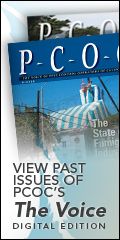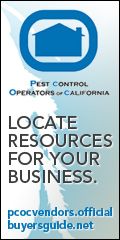
| September 2010 | Past Issues | Printer-Friendly | Advertise | Affiliates Search | Find a Pest Control Operator | PCOC.org |
|
EVP NOTES
I don't know about you, but I have been following the proliferation in the media of articles on bed bugs. Suddenly, it seems – well, we in the industry all know that it really isn't all that sudden – these little critters have popped up on everyone's radar. Newspapers from coast to coast have been reporting on what you need to do when you arrive at a hotel to check for bed bugs. (Most of us have been doing this for six months or more, thanks to the example provided by Gail Getty who has been touting this procedure for a long time!) The national media, TV and radio are all in on the act: NPMA staff have been featured on "Good Morning America" and on NPR. One particular article caught my attention in Bloomberg Businessweek: "From sunny California to New York City, in flophouses, theaters and high-end offices, bed bugs are popping up in droves; although, these days, they're found in a lot more places than just your bed. According to a NPMA/University of Kentucky report, 95 percent of U.S. pest management companies surveyed said they had ‘encountered a bed bug infestation in the past year.' In Ohio, dubbed the new ‘Bed Bug Capital of the United States,' some residents have taken to sleeping in the streets just to get away from their co-habitants." A surge in international travel is being blamed for the "comeback" of bed bugs. As we know, although they don't transmit disease, they are certainly causing a great deal of stress and anxiety. That is why, this month, PCOC and NPMA teamed up with California associations representing hotels and apartment owners, to put on two bed bug seminars. In quite a reversal of our usual events, the attendees were actually from the hotel and apartment industries, whilst the exhibitors were PCOs who exhibit solutions in the marketplace exhibit hall at each conference. The Structural Pest Control Board has put out a request for proposal for a research project to study bed bugs. I think this highlights the importance of this issue. It also draws out attention to the fact that California-based pest control research resources are shrinking dramatically. For example, the UC Berkeley school, headed by Dr. Vernard Lewis, desperately needs funding. It is critically important that we preserve research facilities based in California. At our June board of directors' meeting in Monterey, over $50,000 was pledged by industry to help sustain this important work. It is good to see the pest control industry concerned about its long-term health and involved in projects that help society as a whole. PCOC COMMITTEE CHAIR CONTACT INFORMATION 2010-2011
Advertising Review Committee
Michael Katz, Western Exterminator Company
Lee Whitmore, Beneficial Exterminating
Casey Brierley, Target Specialty Products
P: (408) 293-6032; F: (408) 287-2004; E-mail: casey.brierley@target-specialty.com
Constitution & By-Laws Committee Scott Heinkel, Roadrunner Exterminating
P: (949) 645-3316; F: (949) 722-1633; E-mail: scott@roadrunnerexterminating.com
Convention Steering Committee Joe Gatto, Clark Pest Control
Kathy Burnard, Compass Pest Management
P: (951) 688-8066; F: (951) 688-6294; E-mail: kathyburnard@msn.com
Ethics Committee
Baron McDonald, Clark Pest Control
P: (209) 532-3464; F: (209) 532-2899; E-mail: bmcdonald@clarkpest.com
Fumigation
John Munoz, Mission City Fumigation
P: (408) 275-1046; F: (408) 275-1156; E-mail: jmunoz@missioncity.net
Fumigation Enforcement Committee
John Sansone, Cardinal Professional Products
P: (714) 761-3292; F: (714) 761-2095; E-mail: sansone@pacbell.net
General Pest Committee
Mike Bullert, Big Time Pest Control
P: (530) 242-8830; F: (530) 242-0388; E-mail: mike@bigtimepestcontrol.com
Leadership Conference
Lee Whitmore, Beneficial Exterminating
P: (951) 320-1397; F: (951) 782-8229; E-mail: lee@benexfume.com
Legislative Committee
Curtis Good, Newport Exterminating
P: (949) 261-0700; F: (949) 261-0708; E-mail: curtisg@newportexterminating.com
Liaison to CAR
Dave Watkins, Hydrex Pest Control
P: (805) 925-8711; F: (805) 928-9758; E-mail: dwatkins@hydrex.biz
Membership Committee
Mike McKenzie, Orkin Pest Control
P: (866) 681-6136; F: (626) 282-8508; E-mail: mmckenzie@orkin.com
NPMA Joint Membership Committee
Greg Augustine, Harbor Pest Control
P: (619) 584-8155; F: (619) 584-8183; E-mail: greg@harborpest.com
PAPCO (Political Action for Pest Control Operators)
Mark Kingman, Instar Pest Consultants
P: (408) 985-1701; F: (408) 434-7001; E-mail: instar@worldnet.att.net
Past Presidents
Darrell Ennes, Terminix
P: (916) 773-9557; F: (916) 773-9589; E-mail: dennes@terminix.com
PCOC C.A.R.E.S. & Peacock Group
Lee Blevins, Antimite
P: (909) 606-2300; F: (909) 606-2305; E-mail: ldb@antimite.net
PCOC C.A.R.E.S. Fundraising Committee
Steve Scoville, Pest Control Center
P: (916) 344-4400; F: (916) 334-6712; E-mail: SScoville@pestcontrolcenter.com
Scholarship Committee
Pat Clark, Clark Pest Control – Bakersfield
P: (661) 635-3535; F: (661) 635-4944; E-mail: patclarkzapbugs@aol.com
Termite Committee
Chris Lemon, Orkin Pest Control
P: (866) 677-0004; F: (909) 945-6569; E-mail: clemon@orkin.com
TASK FORCES
Cal-OSHA
Dan Fuentes, Best Care Fumigation
P: (510) 226-1928; F: (510) 226-7766; E-mail: bestcarefume@aol.com
GreenPro Mike Bullert, Big Time Pest Control
P: (530) 242-8830; F: (530) 242-0388; E-mail: mike@bigtimepestcontrol.com
Water Quality/A.B.A.G.
Darren Van Steenwyk, Clark Pest Control – Lodi
P: (209) 368-7152, ext 235; F: (209) 334-5040; E-mail: darrenv@clarkpest.com
LEGISLATIVE UPDATE
UPCOMING EVENTS
2010
September 24-25
Board of Directors Meeting
Doubletree Hotel
Sacramento, CA
December 9
UC Berkeley Golf Tournament
SilverRock Resort
Palm Desert, CA
December 10-11
Board of Directors Meeting
Hilton Palm Springs
Palm Springs, CA
2011
March 25-26
Board of Directors Meeting
Marriott Laguna Cliffs Resort
Dana Point, CA
April 26-27
Legislative Days
Hyatt Regency
Sacramento, CA
June 3-4
Leadership Academy 2011
Silverado Resort
Napa, CA
June 23-25
PCOC's 68th Annual Convention & Tradeshow
Disneyland Hotel
Anaheim, CA
September 23-24
Board of Directors Meeting
Embassy Suites
Lake Tahoe, CA
December 9-10
Board of Directors Meeting
Hilton Palm Springs
Palm Springs, CA
BILLY'S BULLETIN BY BILLY GAITHER
EMPLOYMENT HANDBOOKS: A MUST FOR SMALL BUSINESS OWNERS
The company employment handbook is one of the most important communication tools between your company and your employees. An employment handbook allows you to establish sound, consistent employment expectations for employees in your pest control business, while ensuring compliance with state and federal employment law. Having an employment handbook protects you and your business and provides centralized guidelines for how to run the people-side of your business. The employment handbook allows you to: clarify your expectations for professional conduct, performance, and employment policies with your employees; train your employees in your expectations of their conduct, performance, and employment policies; maintain accountability with employees who act inappropriately in your business; ensure compliance with state and federal employment law, insurance and professional liability requirements; and projects and maintains a professional workplace for your employees. Employment handbooks are a business necessity for all companies and can help protect you from employment liability and wrongful employment actions – which can cost thousands of dollars! Employment handbooks allow you to be PRO-ACTIVE in communicating a professional image to your employees about dress code, customer service, hours of operation, paid time off, time schedules, requesting time off, and many more issues in employment! By having an employment handbook, you provide a consistent, clear, uniform set of guidelines that allows you to manage the human resource issues in your business effectively and efficiently. An employee handbook should be clear and as unambiguous as possible. The following is a SAMPLE list of policies which should be included in your employment handbook:
Don't assume that your employees know how they should act in the workplace ... spell it out in the employment handbook. I advise to you provide each employee with a copy of the handbook and to have each employee sign an acknowledgement of receipt (a copy of which should be provided to the employee and the original placed in the employee's personal file). BED BUG SEMINARS On Sept. 8 and Sept. 10, 2010, I attended both bed bug seminars on behalf of PCOC. Both sessions were very successful, with approximately 125 people attending in Oakland and approximately 150 people attending in Anaheim. At both sessions the attendance was approximately one-third industry, one-third hoteliers and one-third apartment/property managers. Several of our members also participated in the booth exhibition marketplace. The information that was presented was both timely and informative. Both the hotelier managers and apartment/property managers showed great interest in partnering with our industry to educate their industries. These seminars were a win/win situation for everyone. MEMBER VALUE PROGRAM
PCOC MONTHLY INSURANCE/SAFETY TIP
Carpal tunnel syndrome affects approximately two out of every 1,000 workers. Researchers at Washington University Medical School estimated the average lifetime cost of a single case at $30,000 in medical bills and lost time. What is carpal tunnel syndrome? Carpal tunnel syndrome occurs when the median nerve that runs through the carpal tunnel – a narrow passageway at the base of the hand – becomes pinched or compressed. Injury to the wrist or swelling of the tendons in the carpal tunnel can cause the syndrome, as can non-occupational causes such as fluid retention. Symptoms include numbness and tingling of the wrist and hand, which can progress into sharp pain. If left untreated, permanent damage to the median nerve can result. What causes carpal tunnel syndrome? Doctors have associated wrist disorders with repetitive tasks since the 1960s. Carpal tunnel syndrome is also caused by force, cold temperatures, mechanical stress, vibration and poor posture. Who gets carpal tunnel syndrome? Carpal tunnel syndrome occurs three times more often in women than in men, possibly because women have a smaller carpal tunnel than men. Diabetics and those with other metabolic disorders, along with pregnant women, are also more likely to get carpal tunnel syndrome. Increasing job fragmentation; an aging workforce; the increase in keyboard/computer use; improperly designed, one-size-fits-all workstations and machines; and increased workloads caused by downsizing all contribute to the explosion of carpal tunnel syndrome and related repetitive stress injuries.
Case management Case management can help employers reduce the costs of carpal tunnel syndrome. Case managers guide injured workers through treatment and rehabilitation after injury, acting as liaisons between physician and employer, and between injured worker and employer. They can be your own employees, TPAs (third-party administrators) or your insurer's employees. Case managers should analyze injured workers' job tasks, along with home activities and hobbies, past injuries and former occupations to determine possible origins of the injury and to prevent continued problems. The case manager should accompany injured workers on their first visit to the doctor, to review treatment options and become familiar with the treatment plan. This will help you set up alternative work accommodations for the worker, and creates a team atmosphere the injured worker can rely on.
Treatments The best ways to cut the incidence and severity of carpal tunnel syndrome involve changing work methods, retraining workers and modifying computers and other equipment to fit human forms and posture. For immediate symptom relief, the simplest treatments often work best. Your first choice of treatment should be to rest the affected joint; common anti-inflammatory medications, such as ibuprofen, can reduce swelling and pain. A brace or splint that keeps the wrist in a natural position can also reduce irritation and swelling. Surgery is a last resort, and will not succeed unless you modify an injured employee's work methods and equipment. You may not have to completely retool to make your business ergonomically sound – analyze the worksite to see whether retraining employees in proper equipment use will do the trick. OSHA offers several publications with guidelines for instituting ergonomics programs. Outside consultants can review your worksite for ergonomic safety, too. For more information on holding down carpal tunnel and other claims costs in your workplace, please contact the PCOC Insurance Program Department at Jenkins Insurance Group: (877) 860-7378. NEW MEMBERS
FREQUENTLY REQUESTED INFORMATION
TEMPORARY NPMA LOGIN FOR JOINT MEMBERSHIP LOGIN: 313501 PASSWORD: PCOC PCOC Web site password for 2010-2011: "termite" Please remember, the password changes every July 1! Department of Fish & Game Department of Food & Agriculture Department of Pesticide Regulation Find Your Legislator Healthy Schools Act Structural Pest Control Board |
Pest Control Operators of California |
 |






